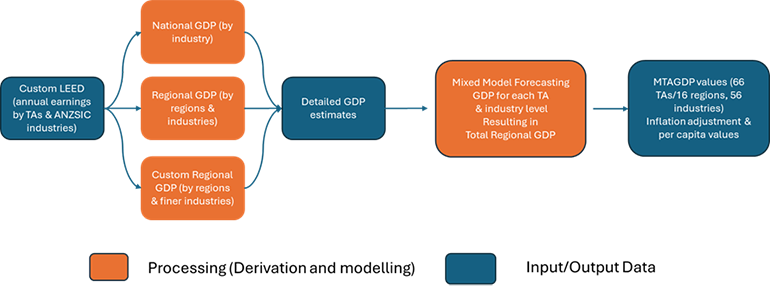Modelled Territorial Authority GDP 2025 release
The experimental Modelled Territorial Authority Gross Domestic Product (MTAGDP) allocates GDP values to second-tier local government administrative boundaries—namely, territorial authorities—based on Stats NZ’s Regional GDP estimates.
On this page I tēnei whārangi
While MTAGDP aims to estimate and allocate GDP to specific territorial authorities, the New Zealand economy operates as a single, interconnected, and interdependent system. No territorial authority is economically self-contained; activities span across territorial and regional boundaries, including non-adjacent regions and international markets. Despite this complexity, there is strong demand for GDP estimates at more granular, local levels.
MTAGDP measures are used to:
- quantify the size of local economies
- promote investment appeal
- highlight the contribution of territorial authorities to regional and national economies.
This modelling approach provides insights at the territorial authority level, supporting a deeper understanding of local economies and their industry structures.
While regional GDP estimates are derived using a bottom-up method based on firm-level data, MTAGDP employs a top-down approach. It begins with regional estimates and disaggregates them to the local level. All annual values are considered estimates, with the latest year’s forecasts marked as provisional.
For the 2025 release, we present results from a refined and enhanced model, including estimates for the year ended March 2024 and updated figures for previous years.
Key findings
Nominal GDP growth
Over the 5 years to March 2024, nominal GDP increased in all but one territorial authority. The 5 largest increases were observed in:
- Selwyn
- Grey
- Invercargill
- Tauranga
- Hamilton.
GDP per capita
Grey and Invercargill recorded the highest increases in GDP per capita. Key contributing industries were:
- Health care and social assistance
- Owner-occupier property operation.
Industry growth nationwide
The top 3 industries with the largest increases were:
- Health care and social assistance
- Construction
- Professional services.
Downloadable data
Nominal CAGR GDP and GDP per capita growth across territorial authorities
Between 2019 and 2024:
- Nominal GDP grew in 65 of 66 territorial authority areas.
- GDP per capita increased in 64 of 66 areas.
As illustrated in Figure 1 and Figure 2, most areas experienced positive growth in both Compounded Annual Growth Rate (CAGR) for GDP and GDP per capita for the year ending March 2024. The top and bottom 10 Territorial Authority for CAGR for GDP are presented below.
Figure 1: 5-year percentage growth in CAGR for nominal GDP and GDP per capita by Territorial Authority (2024)
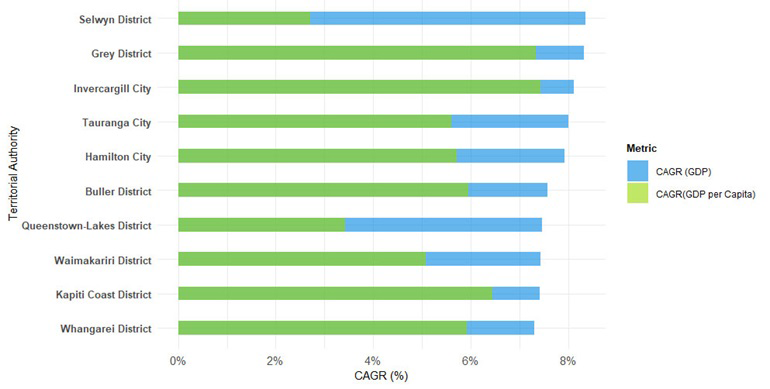
Chart showing the top 10 five year compound annual growth rates (2019-2024) of nominal GDP of Territorial Authority and their corresponding GDP per Capita.
Figure 2: 5-year percentage growth in nominal GDP and GDP per capita by Territorial Authority (2024)
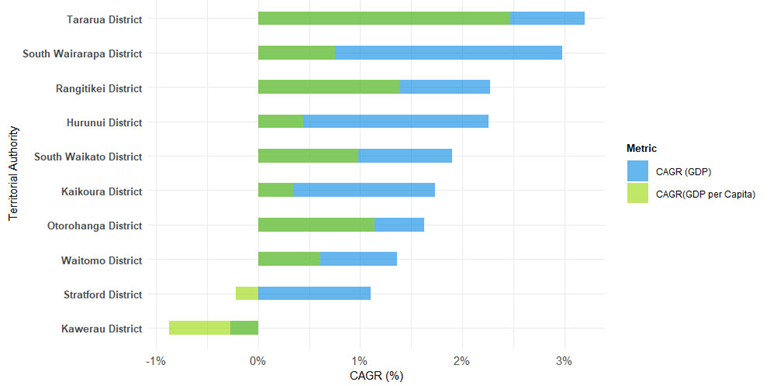
Chart showing the bottom 10 5 year compound annual growth rates (2019-2024) of nominal GDP of Territorial Authority and their corresponding GDP per capita.
Metropolitan comparison
The 3 metropolitan areas are defined as:
- Auckland: Auckland Council area
- Wellington Metro: Wellington City, Lower Hutt City, Upper Hutt City, Porirua City
- Christchurch Metro: Christchurch City, Selwyn, Waimakariri Districts.
Figures 3 and 4 compare these metropolitan areas with provincial regions in the North and South Islands.
- Wellington continues to lead in GDP per capita among metropolitan areas.
- However, since 2009, Wellington’s GDP and GDP per capita growth have been slower compared to Auckland and Christchurch, and even more so compared to provincial South Island regions.
- Provincial North Island recorded the slowest growth in both metrics over the same period.
Figure 3: Normalised nominal GDP per capita for NZ regions (2009 to 2024)
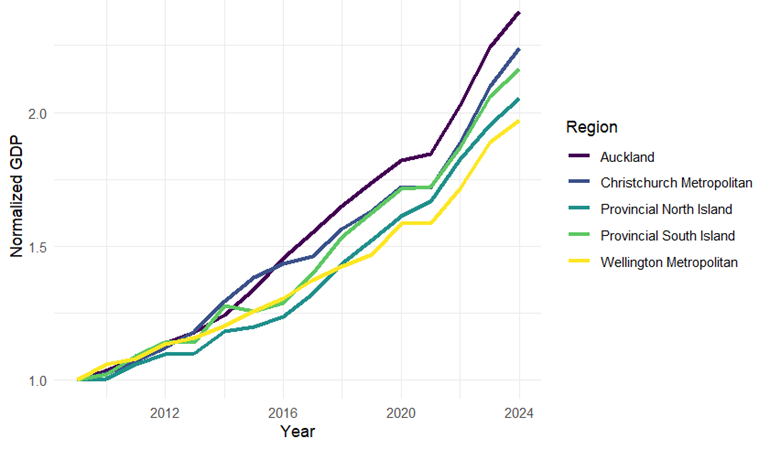
Normalised GDP by region (2009 = 1)
Text description for Figure 3
Figure 4: Annual nominal GDP per capita for NZ regions (2009 to 2024)
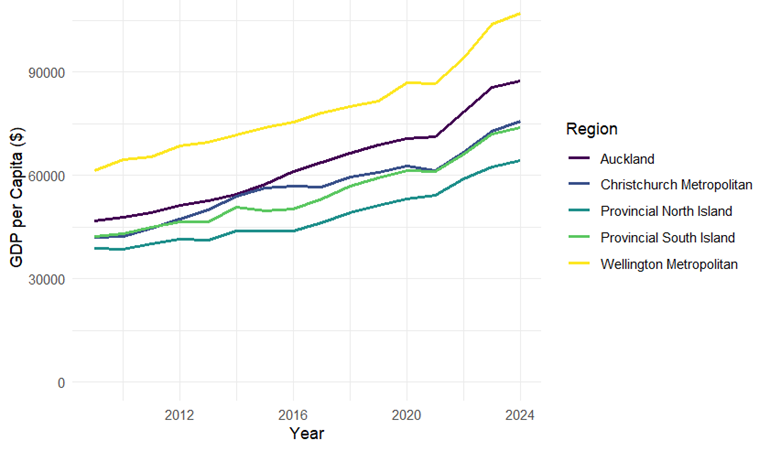
GDP per capita by region (2009 onwards)
Text description for figure 4
Industry trends
Figures 5 and 6 show the industries with strongest and weakest growth from 2019 to 2023.
Strong industry growth
Over the 4 years to 2023, the industries with the most significant growth nationwide were:
- Health care and social assistance
- Construction
- Professional services.
Figure 5: Top 10 industries by GDP growth (2019 to 2023)
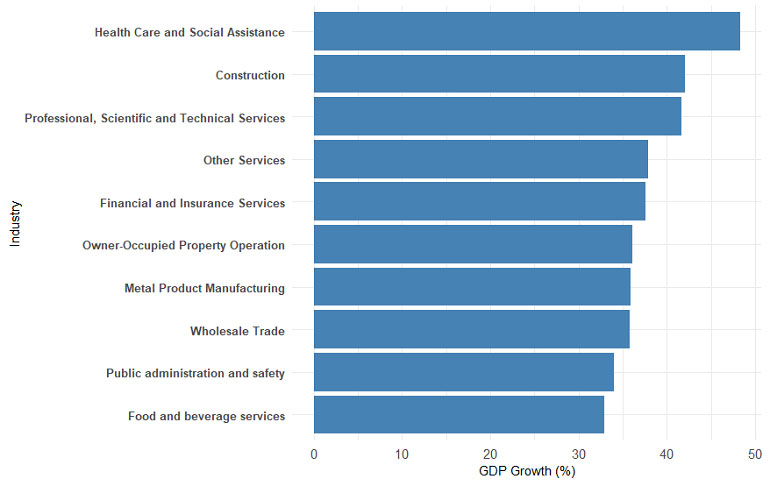
Chart showing the 10 industries that have grown the most between 2019 and 2023.
Weakest industry growth
Over the 4 years to 2023, the industries with the most weakest growth nationwide were:
- Petroleum and related manufacturing
- Forestry and logging.
Figure 6: Bottom 10 industries by GDP growth (2019 to 2023)
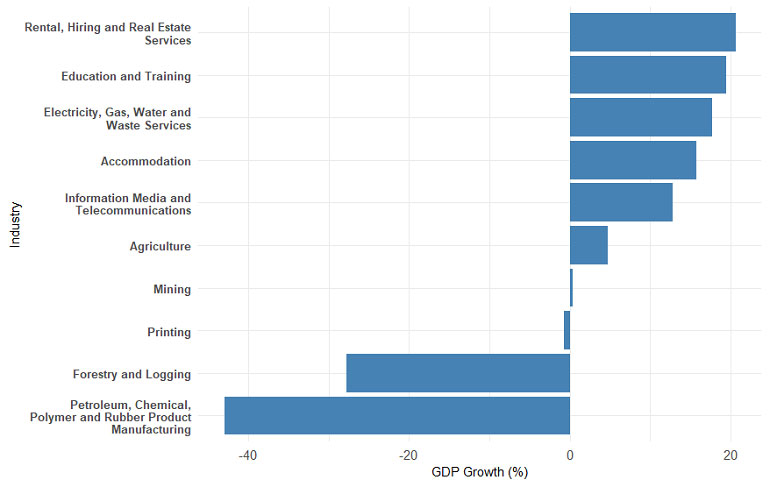
Chart showing the 10 industries that have grown the least between 2019 and 2023.
New methodology and changes from previous releases
This explains the changes we’ve made to how we measure GDP (Gross Domestic Product) for different areas and industries.
Changes
- More industry detail: We now group industries into 56 categories. Before, there were only 32. This gives us a clearer picture of what’s happening in each industry.
- Better way to share GDP across areas: Some territorial authorities (TAs) cross over more than one regional council. We now use population size—not land area—to decide how much GDP goes to each part.
- Improved forecasting: We now use a mix of forecasting methods, not just one. This helps us make better predictions.
- Smarter population estimates: We now use the average population from June at the start and end of each year. This matches how Stats NZ does it and makes our data more accurate.
Findings
When we tested the new method, we saw:
- more detailed data for industries
- more accurate GDP numbers for each TA
- better predictions for total GDP in 2024.
About the MTAGDP data
We reviewed and updated the MTAGDP method in 2025. The data now includes:
- GDP by TA and industry from 2000 to 2023 (year ending March)
- Total GDP by TA for 2024.
We’ve made the method simpler, improved the forecasting, and used better input data.
Important
The raw data used in MTAGDP is based on Stats NZ published and custom data, but the methodology is developed by MBIE. Stats NZ will not be held accountable for any error, inaccurate findings or interpretation within the MTAGDP results.
Due to the experimental nature of this product, it should be used with caution. While care and diligence have been used in developing the data for this product, MBIE cannot warranty it is error-free and will not be liable for any loss or damage suffered by the use, directly or indirectly, of it.
Visual representation of the GDP
